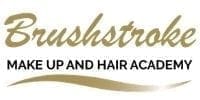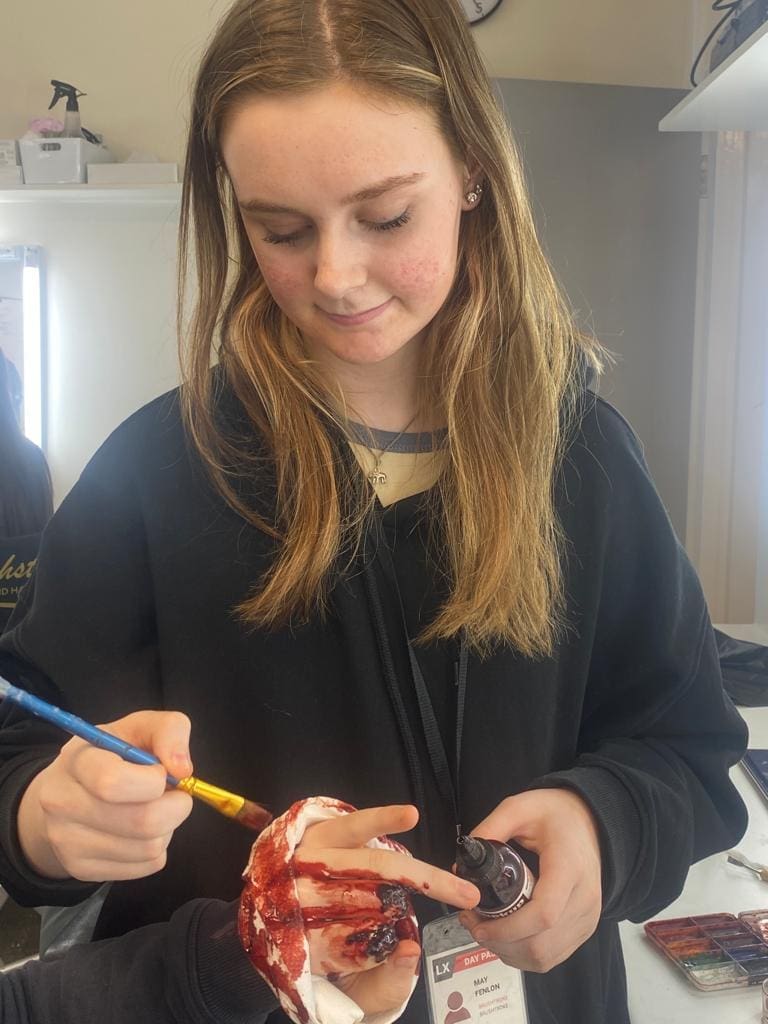What is SFX Makeup?
This comprehensive guide on SFX Makeup looks at the meaning, history, materials and magic used to create to special effects with makeup. Whether you’re a budding artist, a film enthusiast, or just curious about the SFX, get ready to immerse yourself in the fascinating world of SXF makeup.
What Exactly is SFX Makeup?
Special Effects Makeup (SFX Makeup) is a make artistry technique which uses a combination of skin makeup and prosthetic moulds to create hyper-realistic appearances of things like injuries, wounds, scars, cuts and other on-skin enhancements.
From simulating gruesome injuries to bringing mythical creatures to life, its hugely versatile. This article cover a brief history of SXF Makeup, with a deep dive into its processes, tools, and the pivotal role it plays in the entertainment industry. We also look at how training with Brushstroke can give you indispensable skills required to master SFX application
How Does SXF Makeup Differ from Traditional Makeup?
SXF (Special Effects) Makeup and traditional makeup serve distinct purposes, and the differences extend beyond just their end goals. Here’s a succinct comparison:
| Feature | Traditional Makeup | SFX (Special Effects) Makeup |
|---|---|---|
| Purpose | Traditional makeup aims to enhance or subtly change a person’s features, giving a more polished or stylised look | SXF makeup creates dramatic transformations, mimicking injuries, age, creatures, or otherworldly effects. |
| Ingredients | Beauty enhancers, moisturisers, light reflectors. | Specialty ingredients (latex, gelatine). |
| Application Tools | Brushes, sponges, fingertips. | Spatulas, airbrushes, sculpting tools. |
| Effects | From natural to dramatic evening looks. | Simulate scars, wounds, and fantasy characters. |
| Durability & Removal | Daily wear, often easy to remove. | Long-lasting, requires specific removers. |
Where did SXF Makeup Originate?
Special Effects Makeup traces its origins to the early days of cinema when filmmakers sought ways to make their films more visually compelling. While makeup for actors had been around since the days of theatre, the silver screen demanded newer innovations to cater to its ever-evolving storytelling mechanisms and growing audiences.
The initial versions of SFX makeup were rudimentary. In the silent film era, actors utilised exaggerated facial makeup to convey emotions since words couldn’t be heard. But as filmmaking evolved, so did the need for more specialised effects. The 1920s saw the emergence of prosthetics, with actors wearing false noses, and other facial modifications, setting the stage for future innovations.
However, it was the 1930s and 1940s that marked a pivotal turn. Jack Pierce’s iconic work on Universal’s monsters like ‘Frankenstein’ and ‘The Mummy’ showcased the sheer potential of SFX makeup. These characters, with their intricate designs and lifelike semblance, captured audience’s imaginations, making SFX makeup a vital tool in a filmmaker’s arsenal.
The latter half of the 20th century propelled SFX makeup to greater heights. With epic films like “The Exorcist,” “Planet of the Apes,” and John Carpenter’s “The Thing,” audiences were introduced to a new level of realism and creativity. From gruesome, to horrifying, and sometimes outlandish visual effects were no longer mere additions but became integral to the story’s essence.
A significant moment that propelled SFX makeup’s popularity was the establishment of awards recognising this art. When the Academy Awards introduced the category for ‘Best Makeup and Hairstyling,’ in 1982 it was an acknowledgement of SFX makeup’s indelible mark on cinema.
Where CGI and digital effects are now commonplace, SFX makeup still holds its ground, offering tactile realism that CGI cannot. Its rich history, marked by moments of sheer innovation and creativity, remains a testament to its enduring appeal and influence on visual storytelling. Below is a few highlights in SFX development.
| Year/Period | Developer/Innovator | Key Development |
|---|---|---|
| Mid-1920s | Lon Chaney | Pioneered special effects makeup in films such as The Hunchback of Notre Dame and Phantom of the Opera. |
| Early 1930s | Jack Pierce, Boris Karloff | Introduction of innovative makeup techniques in monster movies. Creation of the iconic look for Frankenstein using cotton, spirit gum, and makeup techniques. |
| 1950s | Eiji Tsuburaya, Ishirō Honda | Introduction of tokusatsu genre; Godzilla films, suitmation technique, and scaled-down city sets. |
| 1968 | Stanley Kubrick | 2001: A Space Odyssey; detailed spaceship miniatures, hand-drawn rotoscoping, and front projection. |
| Late 1960s-1970s | Various | Economic downturn leading to rise of independent effects companies. |
| 1977 | George Lucas | Star Wars; "Dykstraflex" camera rig, VistaVision cameras, and thin-emulsion filmstocks. Formation of Industrial Light & Magic (ILM). |
| 1977 | Steven Spielberg, Douglas Trumbull | Close Encounters of the Third Kind; motion-control systems and intentional lens flare technique. |
| 1980s | Various | Introduction of computer-generated imagery (CGI) in films like Tron and Golgo 13: The Professional. |
| 1981 | Douglas Adams, Alan J.W. Bell | The Hitchhiker's Guide to the Galaxy (BBC Series); Innovative use of practical effects and animations to visualise the Guide's entries and depict alien worlds and technology. |
| 1995 | Pixar | Toy Story, blurring the distinction between live-action and animated films. |
| Late 20th Century | Various | Films such as The Abyss, Terminator 2, Star Wars (prequels), The Lord of the Rings, and Avatar showcasing advancements in CGI. |
| 2001 | Peter Jackson | The Lord of the Rings: The Fellowship of the Ring; use of scale doubles, digital grading, and advancements in motion capture with Gollum. |
What Materials Are Used in SXF Makeup?
The realm of Special Effects (SXF) Makeup requires a unique toolkit, vastly different from conventional beauty products. It’s a diverse world of gels, powders, liquids, and prosthetics. Let’s explore some of the common materials and makeup products that bring the magic of SXF to life.
- Liquid Latex: A staple in the SFX makeup toolkit, liquid latex dries clear and is primarily used for creating faux skin effects, such as wrinkles, blisters, or even zombie skin. Brands like Mehron and Kryolan are particularly known for their high-quality liquid latex.
- Foam Latex: This lightweight, breathable material is perfect for creating prosthetic pieces. Once applied, foam latex moves seamlessly with the skin, making it ideal for detailed character transformations.
- Gelatine: A versatile product, gelatine can mimic skin, muscle, or fat. It’s ideal for wounds, scars, and prosthetics.
- Silicone: Silicone rubber is used for encapsulating silicone prosthetics. Smooth-On’s Dragon Skin and PlatSil gels are go-to products for professionals seeking high-quality silicone.
- Alginate: Often used for life casting, alginate captures details meticulously, making it pivotal for creating custom prosthetics.
- Blood Products: No SFX makeup kit is complete without the perfect fake blood, whether it’s coagulated, runny, or aged.
- Adhesives & Removers: Ensuring prosthetics stay intact or are easily removed is paramount.
While this list encapsulates some of the foundational products and brands in the SFX makeup industry, it’s worth noting that the field is vast and continuously evolving. The array of materials available ensures artists can realize even the most ambitious visions with precision and authenticity.
Careers and Further Learning in SFX Makeup
Brushstroke Makeup Academy has made an indelible mark in the world of special effects (SFX) makeup training and career development. We’ve trained some of today’s leading and pioneering makeup artists in film, television and theatre. They learnt from our staff who have numerous years experience working on pioneering SFX films. Aspiring SFX artists can gain significantly from quality education and hands-on experience in field of film and television. Here’s how Brushstroke can help you with your SFX makeup career:
1. Extensive Training
Brushstroke’s range of courses caters to individuals at different stages in their makeup journey. Whether you’re a beginner aiming to get started or a professional looking to specialize, their courses, from the 2-year BTEC to the 7-month ITEC, ensure comprehensive training tailored to the diverse needs of the industry.
2. Real-World Experience
By offering courses at renowned venues like Elstree Studios and Longcross Studios, Brushstroke gives students a real taste of the film and TV environment. This isn’t just learning – it’s practical exposure.
3. Versatility in Training
The SFX world is vast, from intricate alien prosthetics to detailed scars and burns. A successful artist is not only proficient in creating these effects but also understands the basics of makeup and hair. Brushstroke’s curriculum ensures that students are well-rounded and adaptable, a trait highly sought after in the industry.
4. Industry Experts as Tutors
Learning from the best ensures that you become one of the best. With tutors like Barney Nikolic and Catrin Thomas, students get insights from those who’ve not just been there and done that, but who’ve excelled in it.
5. A Blend of History and Modern Techniques
Brushstroke understands that the art of SFX makeup is as much about understanding its history as it is about mastering the current techniques. Their courses weave the traditional with the modern, ensuring artists are well-versed in the field’s evolution.
6. Career Guidance
SFX makeup is not just about learning techniques but also about understanding the industry, the demands of various roles, and the nuances of working on set. Brushstroke’s training goes beyond just the art; it encompasses the entire spectrum of being a professional in the industry.
7. Focus on Prosthetics
Prosthetic makeup is vast and varied. Brushstroke’s emphasis on this skill ensures that students can master the art of lifecasting and create realistic transformations that the industry demands.
8. Holistic Skill Development
Apart from makeup skills, the industry demands other essential traits like understanding briefs, background research, people skills, and presentation abilities. Brushstroke’s curriculum is tailored to ensure students emerge as complete professionals.
Are you interested in a career as an SFX makeup artist? At Brushstroke, we invite you to take the first step towards a rewarding career in the world of special effects makeup. Our comprehensive two-year course provides hands-on training, insights from industry experts, and a deep dive into the art and science of SFX. Whether you’re fuelled by passion or ambition, or both, there’s no better place to nurture your talent. Join us, and let’s craft the future of cinematic artistry together. Your journey into the captivating realm of SFX starts with just one click or call. Join the Brushstroke family today!



